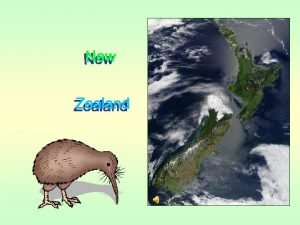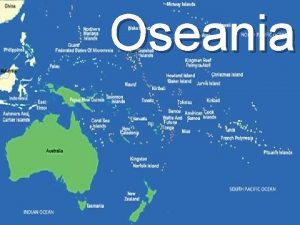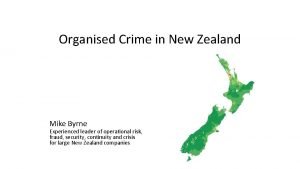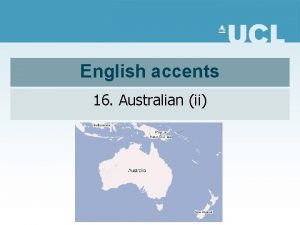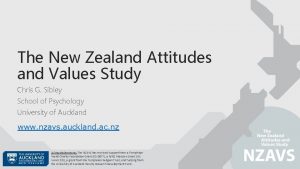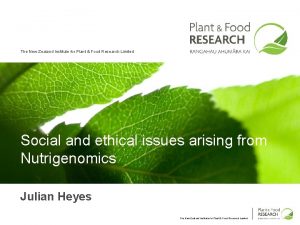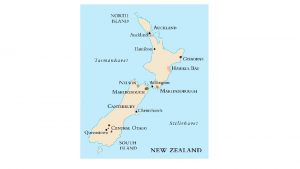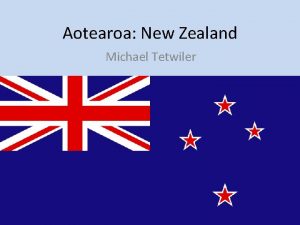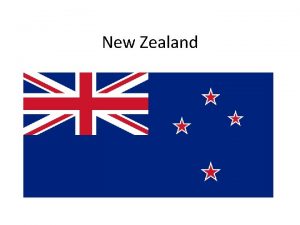The New Zealand Institute for Plant Food Research




















- Slides: 20

The New Zealand Institute for Plant & Food Research Limited Use of Cloud computing in impact assessment of climate change Kwang Soo Kim and Doug Mac. Kenzie

Outline • Introduction • Cloud computing • Case study: Calculation of rainfall frequency in the 21 st century • Results • Conclusions The New Zealand Institute for Plant & Food Research Limited

Climate Change The New Zealand Institute for Plant & Food Research Limited

Impact of climate change • Geographical distribution of species across a wide range of ecosystems (Walther et al. 2002) • The timing of blooming for temperate zone species (Root et al. 2003) • Crop production in positive or negative ways in different regions in the 21 st century (Rosenzweig et al. 2001). Simulation models has been used to assess the impact of Climate change The New Zealand Institute for Plant & Food Research Limited

Computational scale of impact assessment study • The spatial resolution of GCMs has increased » The typical resolution used in the IPCC TAR was about 250 km (Houghton et al. 2001). » In the AR 4, many of those models had higher spatial resolution (Miller et al. 2006). » NCAR-CCSM 3 had spatial resolution of 150 km. • An ensemble prediction system has been used » Probabilistic forecasts of climatic events are generated » Murphy et al. (2004) used a 53 -member ensemble of models to determine the range of climate changes. • Climate change scenarios » The Special Report on Emission Scenarios (SRES) » B 1, A 1 B and A 2 The New Zealand Institute for Plant & Food Research Limited

Cloud computing • A paradigm of computing in which virtualized resources are provided as a service over the Internet (Gruman & Knorr, 2008) • Computing resources “As a Service” » » Infrastructure as a service (Iaa. S) Platform as a service (Paa. S) Software as a service (Saa. S) Data storage as a service (d. Saa. S) • Utility computing • Distributed computing The New Zealand Institute for Plant & Food Research Limited

Amazon web service – Elastic Compute Cloud (EC 2) • Customers can rent computers on which to run their own computer applications • Scalable deployment of applications by creating virtual machines • A customer can create, launch, and terminate server instances as needed • Customers are charged by the hour for active servers » » » » Hourly charge per virtual machine ($0. 10 to $1. 2 per hour) Data transfer charge ($0. 10 to $0. 17 per gigabyte) Allocated and unused Elastic IP address Storage using Amazon Elastic Block Store (EBS) Additional transfer charges using Elastic Load Balancing Using Amazon's Cloud. Watch service to monitor your virtual machine Using Amazon's Elastic Load Balancing which distributes load among selected virtual machine The New Zealand Institute for Plant & Food Research Limited

Science Clouds • The Science Clouds project was initiated by the University of Chicago (UC) and the University of Florida (UFL) (http: //workspace. globus. org/clouds/) » EC 2 -style cloud computing » members of the scientific community to lease resources for short amounts of time • The Science Clouds do not require users to directly pay for usage » Verify the person asking for an allocation is indeed a member of the scientific community » Ask for a short writeup of the scientific project. » Based on the project the individual is allocated a small (testing), middle (development), or large (science) hour credit on the Science Clouds. The New Zealand Institute for Plant & Food Research Limited

Objective • Calculate monthly rainfall frequency in the 21 st century » Daily precipitation (P) was calculated P = RF * 86400 » RF = daily rainfall flux » It was assumed that rainfall occurred on a day when P > 0. 254 mm The New Zealand Institute for Plant & Food Research Limited

Climate projection data • The daily sets of GCM outputs were obtained from the WCRP CMIP 3 multi-model database (https: //esgcet. llnl. gov: 8443). The New Zealand Institute for Plant & Food Research Limited

System architecture The New Zealand Institute for Plant & Food Research Limited

System configuration • Amazon web service EC 2 » Small instances for Server and Client images • Server » Fedora 8 » My. SQL database server » Network file system (NFS) service • Clients » Ubuntu 8. 10 » A script to download a daily climate change dataset from the internet. » The data process program » using Net. CDF file format » search and extract subsets of the original dataset. The New Zealand Institute for Plant & Food Research Limited

Results • The running time using 10 client instances was about 32 hr. • Downloading the climate data » Between 4. 8 hr and 9. 1 hr » Total time was 66 hr • Database transaction » Between 15. 2 hr and 24. 8 hr » Total time was 209 hr The New Zealand Institute for Plant & Food Research Limited

Running time The New Zealand Institute for Plant & Food Research Limited

File size and transfer rate The New Zealand Institute for Plant & Food Research Limited

Database transaction The New Zealand Institute for Plant & Food Research Limited

Computation cost (USD) • CPU: » Downloading/Processing data: (275 hr + 32 hr) x $ 0. 1 = $ 30. 7 » Processing/Downloading results: 42 hr x $ 0. 1 = $ 4. 2 • Transfer: » 70 GB x $ 0. 1 = $ 7 • Storage: » Climate data storage: 30 GB x $ 0. 1 = $ 3 » Database storage: 10 GB x $ 0. 1 = $ 1 • Total cost » $ 46 The New Zealand Institute for Plant & Food Research Limited

Conclusions • Cloud computing could provide inexpensive and temporary computing resources to analyse large-scale scientific data for the climate change impact assessment. » In a 10 processor-core configuration, our approach would be up to 10 times faster than the calculation on a single processor core machine. » The costs for processor core use, data transfer and temporary storage were about $35, $7 and $4, respectively. • Cloud computing have benefits » Running time » Local storage resources » Network resources. The New Zealand Institute for Plant & Food Research Limited

Acknowledgement • New Zealand’s Foundation for Research, Science and Technology through contract CO 2 X 050, Better Border Biosecurity (B 3) (www. b 3 nz. org). The New Zealand Institute for Plant & Food Research Limited

The New Zealand Institute for Plant & Food Research Limited Questions ? Email: kwang. kim@plantandfood. co. nz
 Kumara new zealand food
Kumara new zealand food Kawakawa toilets
Kawakawa toilets New zealand national sport
New zealand national sport New zealand disability strategy
New zealand disability strategy When was new zealand discovered
When was new zealand discovered New zealand vs australian accent
New zealand vs australian accent Lesson 1 physical geography of australia and new zealand
Lesson 1 physical geography of australia and new zealand New zealand alpha lipid
New zealand alpha lipid Why is new zealand a biodiversity hotspot
Why is new zealand a biodiversity hotspot Aotearoa the land of the long white cloud
Aotearoa the land of the long white cloud What is the capital of new zealand?
What is the capital of new zealand? Natives of new zealand
Natives of new zealand Urfolk new zealand
Urfolk new zealand Mike yin new zealand
Mike yin new zealand New zealand health strategy 2016
New zealand health strategy 2016 New zealand holiday 2016
New zealand holiday 2016 Nonrhotic
Nonrhotic New zealand nurse practitioner
New zealand nurse practitioner Saurabh paranjape photography
Saurabh paranjape photography New zealand values and attitudes
New zealand values and attitudes Measurement standards laboratory of new zealand
Measurement standards laboratory of new zealand










